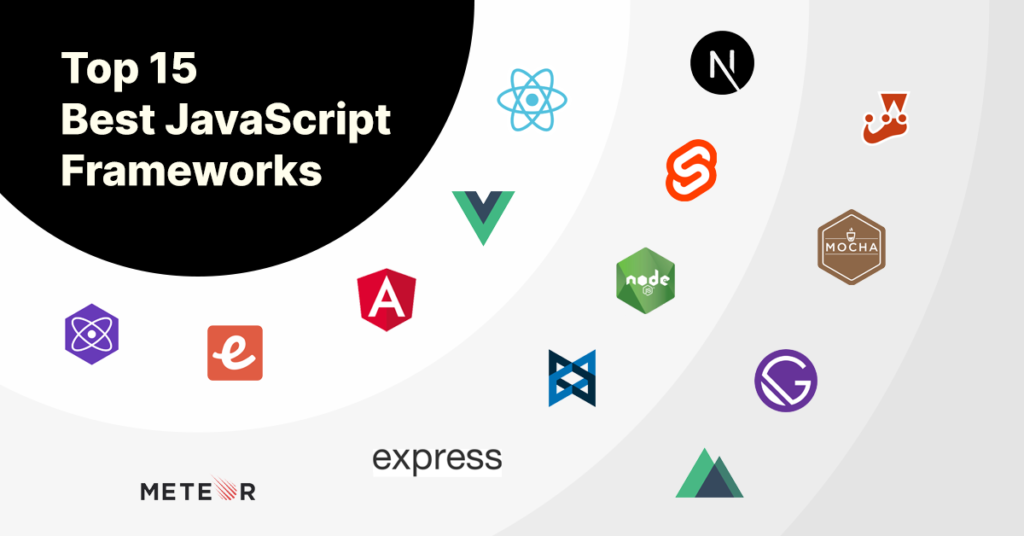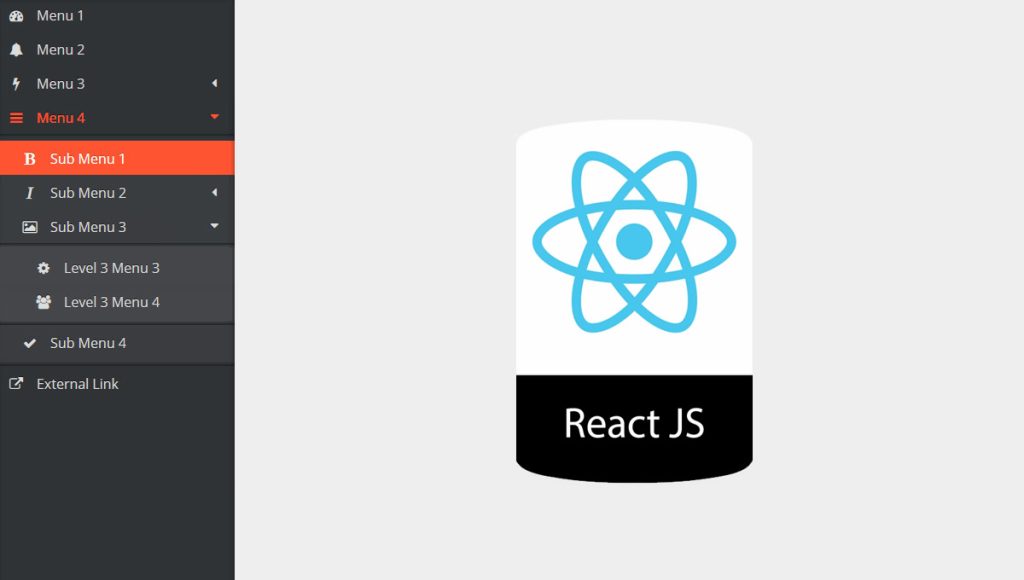Rengga Dev – Top 15 Best JavaScript Frameworks for Web App Development in 2022. With the progression of technologies and versatile online space for web development, the way to build a feature-rich application has become more complicated than before. In the evolving world, just being present online does not satisfy the customer as they want to see your business processes as per the latest trends.
To help you keep in line with customers’ needs, we have many web frameworks in the market. But choosing the right framework can be a tricky task. That’s why in this blog we will learn everything about web frameworks. So let’s get started.
1. React JS: This JS framework helps developers in rolling out interactive UI for a single-page app (SPA). It represents an indicative, handy, and component-based development environment. By using Virtual DOM, React JS propagates fleet-footed rendering.
Pros:
- Developers can benefit a lot from reusable components.
- It can be seamlessly integrated with various frontend and backend frameworks.
- New features and functionalities keep continuously adding with the help of huge community support.
Cons:
- Represents a steep learning curve for newbies.
- Continuous evolution makes it difficult for developers to keep up with the pace.
Prominent websites built with React JS :
Airbnb, Asana, BBC, Cloudflare, Codecademy, Dropbox, Facebook, Github, Imgur, Instagram, Medium, Netflix, OkCupid, Paypal, Periscope, Pinterest, Product Hunt, Reddit, Salesforce, Scribd, Shopify, Slack, Snapchat, Squarespace, Tesla, The New York times, Typeform, Twitter, Uber, Udemy, WhatsApp, and Zendesk.
2. Vue Js: This highly flexible technology not only works as a comprehensive feature-rich framework but also acts as a view layer with state management as a whole. It’s a tool that offers two-way data binding and helps developers in creating interactive web and mobile apps.
Pros:
- Its built-in MVC allows easy and quick configuration.
- It’s lightweight and easy to learn.
- It displays strong documentation as compared to other JS frameworks.
Cons:
- Its community of developers is getting skilled day by day.
- It’s still gaining popularity in the US and has limited opportunities.
Prominent websites built with Vue Js:
9gag, Adobe, Apple Swift UI, Behance, Bilibili, BMW, Chess, Font Awesome, Gitlab, Hack the box, Laravel, Laracasts, Louis Vuitton, Namecheap, Netlify, Netguru, Nintendo, Pluralsight, Pornhub, Shien, Stack overflow, Trivago, Trustpilot, Upwork, Wizzair, and Zoom.
3. Angular JS: Angular JS is an open-source typescript-enabled tool to develop client-side SPAs. Integrated with a component-based architecture, this platform stands tall as one of the most secure frontend JavaScript frameworks for designing enterprise-grade apps.
Pros:
- It assists an enormous amount of features and out-of-the-box caching to offer fast server performance.
- Its two-way data binding feature helps to establish a strong link between and Model and View layer.
- Offers seamless enterprise-grade web application development experience.
Cons:
- It’s heavyweight and poses learning challenges for novices.
- Migrating from Angular 1 to the latest version of Angular is a bit complicated.
Prominent websites built with Angular JS:
Google, Allegro, Blender, Clickup, Clockify, Delta, Deutsche Bank, DoubleClick, Freelancer, Forbes, Guardian, IBM, Instapage, iStock, JetBlue, Lego, Mailerlite, Microsoft Office, Mixer, Udacity, Upwork, Vevo, Walmart, Weather, WikiWand, Xbox, and YouTube.
4. Ember JS: This open-source JS framework is backed by a Model-View-ViewModel (MVVW) architecture strategy. What makes it stand out is its command-line interface tool that offers end-to-end operational productivity.
Pros:
- It offers a basic mechanism to handle APIs.
- Its Convention over Configuration (CoC) approach helps developers to focus on coding rather than configuration.
- Developers can kickstart their projects in Ember with upright documentation and support.
Cons:
- Newcomers may find it challenging due to its steep learning curve.
- While developing large-scale apps is easier, Ember proves heavy for small-scale app development.
Prominent websites built with Ember JS:
Crowdstrike, Ghost, GroupOn, Heroku, Intercom, LinkedIn, Microsoft, Netflix, Skylight, Square, TED, Twitch, Yahoo, and Zendesk.
5. Preact JS: Similar to React JS, this framework signifies component-based programming style and pattern. Its compatibility with React makes it the best JavaScript framework to opt for. It’s highly recommended to accelerate project performance.
Pros:
- It’s lightweight and offers high performance and efficiency.
- Its CLI tool helps developers in creating new projects easily.
- Its LinkState module supports state changes optimization.
Cons:
- It’s still getting popular and is supported by a small community of programmers.
- It offers limited support for propTypes and createClass.
Prominent websites built with Preact JS:
Bluehive, Bustle, Dailymotion, Dev.to, Dominos, Financial Times, GroupOn, Hashi Corp, Housing.com, Lyft, Pepsi, Rocket Chat, Smashing Magazine, Synacor, Sogou Wenen, Tencent, Treebo, and Uber.
6. Svelte JS: With Svelte JS, you can create boilerplate-free components in simple CSS, JavaScript, and HTML code. The framework displays no client-side dependencies and helps developers in building high-end user-friendly applications.
Pros:
- Easy to learn and understand and is small in size.
- It supports faster rendering as compared to its competitors.
- Proves to be SEO-friendly.
Cons:
- It falls short in terms of community and resources.
- Poor debugging due to undeveloped tooling mechanism.
Prominent websites built with Svelte JS:
1Password, AB Lab, Absolute Web, Bekchy, BlueHive, Cashfree, Chess, Comigo, Entur, Farmbox, Fusion Charts, Godaddy, HealthTree, Rakuten, Razorpay, and The New York Times.
7. Node JS: It belongs to the list of popular frontend JS frameworks that helps in designing full-fledged web, mobile, and hybrid apps. Experts suggest this technology advancement gets intuitive IoT solutions, REST APIs, and desktop programs onboard.
Pros:
- As it uses JavaScript, newbies can easily learn, understand, and practice it.
- The Node packaged modules (NPM) are continuously evolving.
- With Node JS, your can stream large files.
Cons:
- Dealing with a relational database is nothing less than a challenge.
- Not suggested for CPU-intensive tasks and is not scalable.
Prominent websites built with Node JS:
LinkedIn, Netflix, Uber, Trello, PayPal, NASA, eBay, Medium, Groupon, Walmart, Mozilla, and GoDaddy.
8. Backbone JS: It’s a lightweight framework that enables your programmers to work on the JS code in a Model View Controller (MVC) manner. It communicates through events that help in writing clean, concise codes and developing dynamic web as well as mobile applications.
Pros:
- It gives full control over performance.
- Developers prefer this framework for designing intuitive frontend.
- Its library offers good optimization for designing an app.
Cons:
- It runs low on productivity and has an indistinct architecture.
- There are chances of memory leakage while writing code.
Prominent websites built with Backbone JS:
Airbnb, Trello, Foursquare, SoundCloud, Bitbucket, Basecamp Calendar, Flowdock, Cocktail Search, Hulu, and Countly.
9. Express JS: One of the key benefits of using the Express JS framework is fast server-side coding. Your developers can complete complex tasks in just a few minutes. It also takes care of dynamic URLS with its active routing mechanism.
Pros:
- It’s backed by a huge community of developers with decent documentation and resources.
- Developing web-based apps are much faster as compared to other JavaScript frameworks.
- Provides good connectivity with various popular databases such as Redis, MongoDB, etc.
Cons:
- This framework is not opinionated, which makes it difficult for beginners to learn and practice.
- It does not facilitate any kind of security feature.
Prominent websites built with Express JS:
Accenture, Coursera, Exove, Fox, Godaddy, IBM, Myntra, Nike, Paypal, Pluralsight, Quizup, Ripjar, Sony Playstation, Twitter, Uber, Unsplash, and Yandex.
10. Meteor JS: It showcases all the capabilities of being the best JavaScript framework and is highly preferred for creating a backend effectively. It helps developers to work on the backend without tossing between languages such as Python, PHP, etc.
Pros:
- It’s easy to learn and understand with clear documentation and resources.
- It hosts sought-after libraries and packages.
- It helps to achieve seamless client-server communication.
Cons:
- It lacks a server-side rendering facility.
- There is an absence of the needed support to develop progressive web applications.
Prominent websites built with Meteor JS:
Tencent Cloud, Hotmart, Lemlist, Crackwatch, RED by SFR, CodeSignal, Any Run, Telescope, and Escape Client SFR.
11. Next JS: Based on React, this Javascript framework helps in achieving comprehensive server-side rendering. It’s designed with the aim of ‘develop once, run everywhere and provides static generations as well, making mobile and web app development easier.
Pros:
- Its features like automatic code splitting and hot code reloading improve operational efficiencies.
- Offers good SEO performance due to SSR capability.
- It’s recommended for all types of websites and applications – web, mobile, progressive, etc.
Cons:
- Sometimes you have to deal with performance issues.
- It is precisely designed for React.
Prominent websites built with Next JS:
Auth0, Binance, Coinbase, Docker, Github, Hulu, Invision, Magic Leap, Netflix, Sesame, Starbucks, Trulia, Tencent, Twitch, and Uber.
12. Gatsby JS: With Gatsby, users can get information from any data source. Instead of being an SSR, this framework broadcasts content on the client-side in build time. This helps in offering unmatched security and SEO outputs in the longer run.
Pros:
- It maximizes the performance of website and app development.
- It’s SEO-friendly and secure with no additional dependencies.
- It offers plugins for every task with its wide-ranging plugin capacity.
Cons:
- Experts don’t suggest it for building large scale websites
- You need to acquire some knowledge about React and GraphQI to learn and use Gatsby JS.
Prominent websites built with Gatsby JS:
Airbnb, Braun, edx.org, Fabric, Figma, Flamingo, Freecodecamp, Ghost, Hopper, Impossible, Nike, Paypal, React, Segment, Sendgrid, and Snapkit.
13. Nuxt JS: Based on Vue, Nuxt JS stands among the best open-source backend JavaScript frameworks with the ability to develop feature-packed web apps. It creates a progressive development environment and is recognized as a Vue enhancer.
Pros:
- It has a great potential to develop Universal apps.
- You can start a new project in just a few minutes with its self-initiating setup and configuration.
- It’s supported by a large community of starter kits, libraries, and many APIs.
Cons:
- Integrating custom libraries is a complex process.
- The documentation and resources are not enough to make a head start.
Prominent websites built with Nuxt JS:
Aircall, Amplitude, Backmarket, Bitpay, Bootstrap Vue, Fox News, Gitlab, Icons8, Instrument, MyScript, Nespresso, Note.com, Ozon.ru, Roland Garros, System76, Todoist, Upwork, and Wappalyzer.
14. Jest: An independent stateofjs survey claims Jest to be the best JavaScript framework. Created by Facebook, this technology platform defines the true essence of effortlessness. Developers use it for JS automated testing by coupling it with Selenium.
Pros:
- It supports auto mocking and snapshot testing.
- It’s officially managed by React developer tools.
- It carries enough potential for React native testing.
Cons:
- Auto mocking makes it slower.
- Has poor documentation.
Prominent websites built with Jest:
Airbnb, Bla Bla Car, Circle Cl, Facebook, Instagram, Intuit, One football, Revolut, Spotify, Stack, Swat.io, The New York Times, Travel Perk, and Twitter.
15. Mocha: Ideally used for asynchronous testing, the Mocha development framework basically runs on Node JS. It involves serial testing supported by agile and precise reporting. It efficiently supports Test-driven as well as Behaviour-driven development environments.
Pros:
- It’s highly flexible to finish recurring tasks.
- Stimulates a faster testing environment.
- Its popularity among the JS frameworks is growing with each passing day.
Cons:
- It represents complex auto mocking and snapshot testing.
- Excess configuration requirement makes it weaker.
Prominent websites built with Mocha:
Accenture, Algolia, Asana, Clay, Codefirst, Coursera, Netlify, Open Collective, Principal, Third Iron, Triple Byte, Typeform, UX Planet, Webflow, Wix, and Yahoo.
Why Use JavaScript Frameworks?
Now as you have come across the pros, cons, and use cases of the above frameworks, here’re some detailed insights on why using the best JavaScript framework is becoming the need of the hour.
Global Assistance: JavaScript frameworks are used by beginners as well as seasoned developers all across the globe. Besides, the programming language is supported by a huge community at present.
Well-structured: You need to use JS frameworks to reap the full benefits of its structure. The reason why these frameworks are called structured is the syntax using control flow. It also consists of both block scoping and functions, which is a very unique trait as compared to other frameworks.
Dynamic: JavaScript is the only programming language that the browser can easily understand. This ability helps the developers to build the browser in a more effective manner.
Object-oriented: Being object-oriented, the best JS framework uses objective prototypes rather than classes for inheritance that help coders in customizing the classes and direct functions in the code.
Delegative: When you use a JS framework, your project shall assist exhaustive delegation. Your developers can easily write event handlers that retort to users and additional events.
Multipurpose: JavaScript is a programming language that can be optimized for various small as well as large platforms of apps such as game development, animation, retail, etc.














